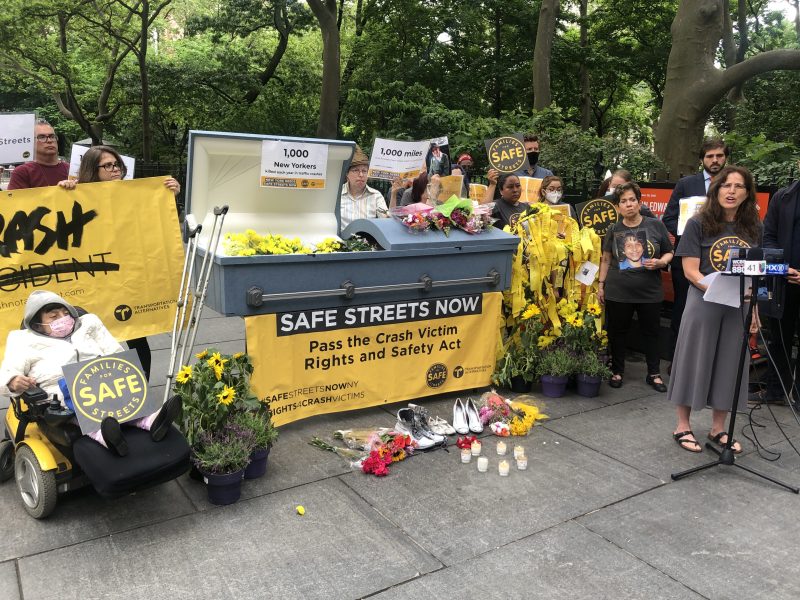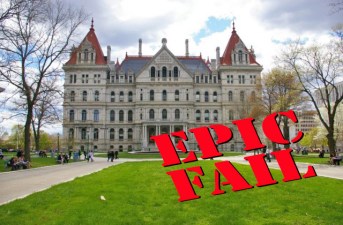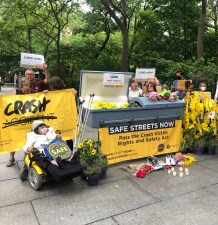SAFETY LAST: Albany Pols Stall on Package of Bills to Make Roadways Safer

Albany has served up a nothingburger for dessert.
Both the Senate and Assembly transportation committees adjourned for the year without taking up a vital package of eight safety bills dubbed the Crash Victims Rights and Safety Act, leaving in doubt whether any of the safety measures will be taken up before the legislative session ends on June 10.
Assembly Transportation Committee Chairman William Magnarelli’s failure to move the package was particularly shocking to street safety advocates because final committee hearing on Thursday took up only two issues: a bunch of street re-namings and a truck weight pilot study for the Brooklyn-Queens Expressway.
Magnarelli, a Syracuse Democrat, declined to comment for this story.
Meanwhile, Magnarelli’s Senate counterpart, Tim Kennedy of Buffalo, also put down his gavel without moving the package, either.
His committee’s apparent final meeting, on May 19, took up some weighty matters and name changes, but also Kennedy’s own bill to establish a “hyperloop and high speed rail commission.” (Kennedy declined to comment for this story, but a staff member told Streetsblog that the senator hoped to pick up the legislation in the future.)
State Senator Brad Hoylman, who is sponsoring one of the safety bills, doesn’t want to wait until the legislature returns next January.
“What are we doing? Are we going to wait another six months?” asked Hoylman, whose bill would allow the city to not need state approval for speed limit reductions. The bill is named for Samuel Cohen Eckstein, a 12-year-old boy killed in Brooklyn in 2013. “Senators that do not represent New York City do not get it, but they should be deferring to their colleagues. The fact that Albany has a stranglehold over issues as fundamental as speed cameras and speed limits is clearly intended to benefit automobile drivers at the expense of our pedestrian’s safety.”
His colleague, Senator Andrew Gounardes of Bay Ridge, was equally frustrated.
“I do not see the reason for any delay,” said Gounardes, who is sponsoring six pieces of legislation in the “common-sense” package.
Experts say there is still hope that the bills in the package can be passed before the June 10 deadline if the committees reconvene. Marco Conner DiAquoi, the deputy director of Transportation Alternatives said Sammy’s Law is being help up solely by Magnarelli, not by opposition to the proposal, which has broad support from the public and Mayor de Blasio, who called for its passage at last month’s funeral of NYPD officer Anastasios Tsakos, who was killed by a drunk driver.
“Only reason it is not passed is because Magnarelli is not bringing it up,” said DiAquoi. “Only inaction would kill this bill. The City of New York wants Sammy’s Law. The mayor wants it.”
The bills in the package are:
- Sammy’s Law (S524A/A4655) would allow the city to lower its speed limit without state approval.
- Pre-test driver education bills (S1078A/A5084) would require specific training for new motorists on how to deal with cyclists and pedestrians. This bill has passed the Senate only.
- Dangerous Driving “Rule of Two” (S7894/A8881A) would clarify existing law to address allow prosecutions of drivers for committing one moving violation instead of requiring two wrongful acts such as speeding, running a red, failure to yield, etc. The legislation would also replace “reckless” with “dangerous” in “reckless driving” so that prosecutors no longer have to prove that a driver willfully committed a violent act with a car.
- Vehicle Safety Rating (S4307/A575) would require the state DOT and the state Department of Motor Vehicles to create a safety-rating system to assess the risk a motor vehicle poses to vulnerable road users, and would require that such ratings be displayed at the point of sale and on a state website. No safety-rating system exists for risks a vehicle poses to people outside a car, which are especially acute for large, heavy vehicles. In New York City, 25 of the 29 cyclists who were killed in 2019 were killed by drivers of large trucks, buses, SUVs or vans.
- Speed-Safety Camera Improvement (S5602/A6681) would authorize New York City to operate speed-safety cameras 24/7, would escalate penalties for extreme repeat offenders, including license suspension and would allow records of speeding to be shared with auto insurance companies.
- Traffic-Crash-Victim Bill of Rights which gives crash victims rights like those of the federal Crime Victims’ Rights Act, including the right to receive timely crash reports and the right to attend crash-related hearings and submit impact statements. It would also require the state to report data about crash-victim compensation and support, including no-fault insurance and private insurance.
- Blood-Alcohol Content Lowered to .05 (S131/A7197) would lower the blood alcohol concentration limit for driving from .08 percent to .05 percent because drivers are likely to be impaired at the current level. The bill has been introduced every session since 2013.
- Safe Passage For Cyclists (S4529/A547) would provide a clear objective definition of what a “safe distance” is for motorists when overtaking bicyclists on the road (at least three feet), provide a mechanism for accountability following a crash, and foster a culture of safer driving through education. The Senate version has passed, though it carved out New York City for this vital safety improvement.
Support for Sammy’s Law is widespread, Streetblog reported. Transportation Alternatives provided a survey done by Emerson College polling that 72 percent of city voters said yes when asked, “Do you support giving New York City local control to lower speed limits on select residential streets?” Only 19 percent opposed. And 68 percent of New Yorkers said they would “personally like to see the speed limit reduced from 25 to 20 miles per hour on residential streets.” Only 31 percent opposed.
In a final push for the legislative package, supporters rallied at City Hall Park with a flower-filled casket, candles and shoes representing victims.

That rally came after a 1,000-mile trip by activists around the state to mark the number of people who died every year on streets statewide. At the launch of the four-day trip, activists were joined by Dr. Nicholas Gavin of New York Presbyterian Hospital, who supports the package because he believes it will stem the blood tide that shows up at his ER every day.
“Just in the building behind us we see a dozen people a day who are victims of pedestrian crashes and bike accidents,” said Gavin, who joined members of Families for Safe Streets on Tuesday in front of in Washington Heights, where activists began a last statewide push for the package. “All of those issues show up at our front door everyday.”
“If we learned anything from the Covid-19, we have learned that systems lead to outcomes and that policy is good for results,” said Gavin. “We need to have the same level of focus and energy on the pandemic that is affecting our streets resulting in traffic violence that leads to preventable deaths.”
Gavin, an emergency room physician, is just the latest frontline worker to align himself with Families For Safe Streets in hopes of preventing these all-too-preventable crashes.

